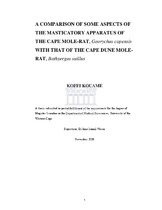| dc.description.abstract | Some African mole-rats of the family Bathyergidea have dramatically different
ecological niches which may cause selective anatomical adaptations. Bathyergus
suillus lives in sandy soil and eats a wide range of food whereas Georychus
capensis is restricted to the mountainous hard soil and eats mainly geophytes.
Georychus capensis is considered a chisel-tooth digger in that it uses its incisors
to dislodge soil while Bathyergus suillus is a scratch-digger that uses both its
incisors and large front paws to dislodge soil. The purpose of this study was to
compare certain aspects of the masticatory anatomy of Bathyergus suillus and
Georychus capensis. In particular the question that drives this study is: Do the
differences in ecology of the two species reflect in the anatomical adaptation of
their masticatory apparatus? Nine whole body specimens of each species were obtained for this study. The masticatory apparatus of each specimen was dissected, examined and analysed.Selected bones of their skulls were investigated to determine their gross morphology. Digitalized images were captured by a high-resolution Olympus digital camera and were analysed by DOCU analysis software, in order to determine the morphometric parameters. In addition, the cleaned skulls of each species were weighed with a chemical balance. In order to make the comparison of the four muscles of mastication more effective than when using only their linear measurements, the mass (in grams) of each skull was divided by the length of each metric traits squared in order to yield their respective indices. Various statistical tests were used.This study has thus revealed some dissimilarities between the two species.Comparison of the two species reveals that one of the more distinguishing differences between the two is their upper incisors. There are also significant differences in the morphology and dimensions of their angular plates. And the external pterygoid muscle is significantly larger in Georychus capensis than in Bathyergus suillus, there are no significant differences between the others of the masticatory muscles of the two species.The feeding and foraging activities of Bathyergus suillus as well as Georychus capensis have close relationship with their lifestyles (digging abilities and adaptations). Bathyergus suillus is predisposed to dig with its incisors as well as its large front paws, and the range of food is large, whereas Georychus capensis uses its incisors only to dig, and the range of food is limited. Subsequently the skull of Bathyergus suillus is bigger than Georychus capensis. But, due to the environment of the latter, strong incisors are needed to perform its feeding and digging activities. The investigation thus reveals that the two selected species have successfully adapted their anatomical masticatory elements to their environments. | en_US |

